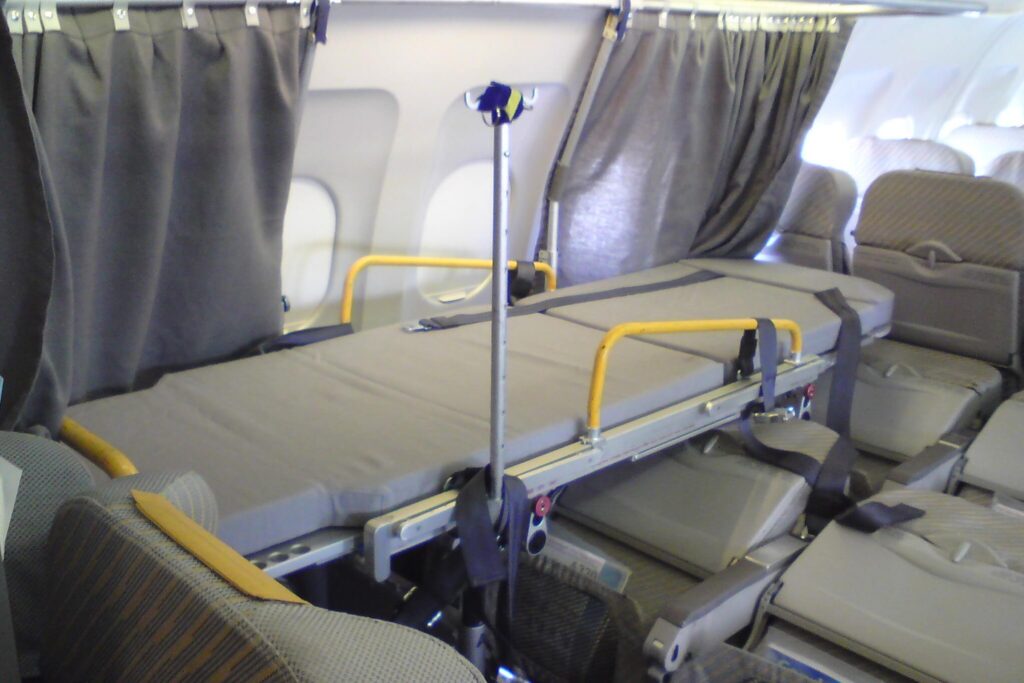The aviation industry doesn’t just provide employment, economic growth, and rapid connectivity across the world, it also plays an essential role in transporting food to remote locations, conducting search and rescue operations, and is even involved in rapid medical repatriation.
While serious medical emergencies typically require an air ambulance or helicopter, medical repatriation can also take place on a commercial flight.
But just how easy it is to transport a patient via a scheduled flight? What are the logistical issues? And what are the positives? AeroTime investigates.
Medical repatriation on scheduled flights – commonplace or a rare occurrence?
There are many reasons why people need air medical services, including commercial airline repatriation. While severely injured or ill patients are typically taken care of by a private air ambulance, helicopters or executive jets, medical repatriation on a commercial flight can be a viable alternative depending on the patient’s medical state and the flight route.
Medical repatriation on commercial flights is a common practice in the global healthcare and aero-medical industry, managing director at the European Aero-Medical Institute (EURAMI), Claudia Schmiedhuber told AeroTime.
“There are several companies within the global industry that are specialized in this sector and provide commercial airline medical escorts to thousands of patients every year. Medical escorts take place every day all over the world,” Schmiedhuber said.
Generally, all commercial airlines that take patients on board require a pre-travel medical clearance, called Medical Information Form (MEDIF), which must be approved well in advance by the carrier’s medical department. The patient’s medical repatriation can only take place with the clearance.
Schmiedhuber added: “Usually, most of the commercial airlines allow for commercial medical repatriations to take place on their aircraft. However, there are limits in route network and the patient’s conditions which might cause repatriation to be denied.”
What are the options for medical repatriation on commercial flights?
Generally, there are three different ways for patients to fly commercially, according to a Medical Air Service report. These are commercial airline repatriation with a medical escort, commercial airline repatriation on a stretcher, and commercial repatriation in a patient transport compartment (PTC).
Depending on the needs of the passenger and the approval of the airline, patients can be accompanied by a medical crew. Ordinally, patients with a medical escort must book either business or first-class cabins, meaning that the possibility of traveling with a low-cost carrier is greatly reduced.
Commercial airline stretcher repatriations can be conducted where patients may not be able to use first or business class seating due to physical limitations from injury or illness. The commercial airline stretcher service is usually accommodated at the back of the airplane with a temporary screen to allow for privacy during the flight.
Meanwhile, seriously ill passengers who need intensive care have the option to travel lying down in a patient transport compartment (PTC). The medical and technical equipment in a PTC is equivalent to that in an air ambulance.
However, it is worth noting that there are only a few carriers that allow flights with a stretcher or patient transport compartment services.
“Not all patients are allowed to travel commercially.”
“It must be understood that airlines do not accept all patients on their aircraft,” Schmiedhuber told AeroTime.
“Reasons to deny a patient might be, for example, a serious condition, patients who cannot sit up for departure and landing,” Schmiedhuber explained.
In addition, being able to fly commercially may be denied if the patient’s health condition endangers other passengers. For example, patients with infectious diseases or, in some cases, mental health conditions must be taken care of by an air ambulance.
What are the main logistical challenges?
While commercial airline repatriation is a low-cost alternative to traditional air ambulance or helicopter services, there are several logistical challenges, Schmiedhuber explained.
Major challenges include receiving medical clearance and assuring that all necessary equipment is being carried. In addition, time management becomes an important factor when an injured or ill passenger has a connecting flight.
“Traveling with a medical patient normally requires more time when transferring to a different flight,” Schmiedhuber said. “Also, with the recent ever-changing COVID-19 related restrictions it has become complicated to assure smooth journey. Organizing transportation very much depends on the patient’s location, destination as well as the patient’s condition.”
Not surprisingly, planning for a medical airline repatriation can range from a few hours to multiple days. But despite the challenges linked to transporting patients commercially, Schmiedhuber said that there are many advantages to medical repatriation on a scheduled flight.
“Patients can travel quite comfortably with sufficient space for medical care, shorter connections and flight times as well as cost-effectiveness,” Schmiedhuber explained.
For instance, the cost of commercial airline repatriation can start from roughly $10,000, while the cost of air ambulance services can start at $30,000.
Will medical airline repatriation become even more prevalent?
While medical airline repatriation cannot entirely replace air ambulance or helicopter services, the transportation of injured or seriously ill passengers on scheduled operations will likely begin to rise.
“I believe that we will see an increase in travel activity over the next few years which will increase the demand for medical repatriations on both air ambulance and commercial carriers,” Schmiedhuber explained. “One aspect in favor of commercial carriers is that we see more and more routes being developed which will help to transfer patients with less connections necessary.”
Schmiedhuber added: “I think that we will see more commercial medical repatriations being performed in the future and more carriers adapting their fleet and service offerings.”

